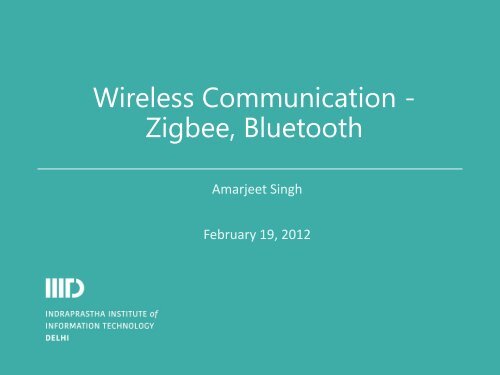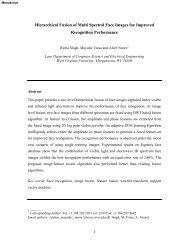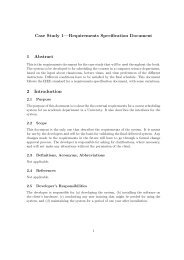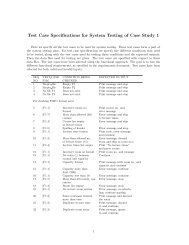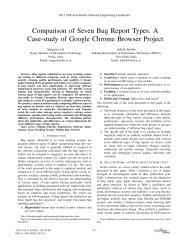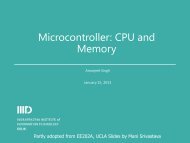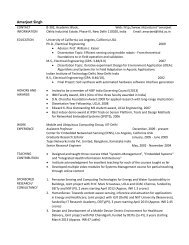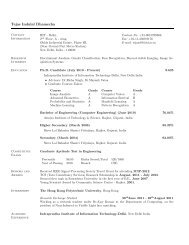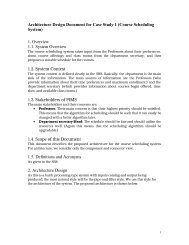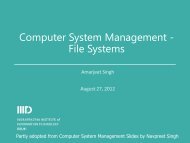Wireless Communication - Zigbee, Bluetooth - IIIT
Wireless Communication - Zigbee, Bluetooth - IIIT
Wireless Communication - Zigbee, Bluetooth - IIIT
Create successful ePaper yourself
Turn your PDF publications into a flip-book with our unique Google optimized e-Paper software.
<strong>Wireless</strong> <strong>Communication</strong> -<br />
<strong>Zigbee</strong>, <strong>Bluetooth</strong><br />
Amarjeet Singh<br />
February 19, 2012
Logistics<br />
Sample exam paper on the course website<br />
Derived from mid term exam of last year – will give you an idea<br />
of what can be asked in the exam<br />
Will create projects for those who did not get it since all topics were<br />
over<br />
Will create the presentation schedule for students by this weekend<br />
2
Revision from last class - I<br />
UART<br />
What are specific example interfaces?<br />
RS-232:<br />
How do you make a minimum interface (with/without<br />
handshaking)?<br />
How will you support RS-232 with UART in your microcontroller?<br />
RS-422:<br />
How is it different from RS-232?<br />
How is it extended to support multi-device bus?<br />
Infrared:<br />
How is it different from RS-232?<br />
What bit-encodings are used in infrared?<br />
3
Revision from last class - II<br />
USB:<br />
What does a USB packet contain?<br />
What are different types of token packets?<br />
What are different types of handshake packets?<br />
What are different types of data transfers supported?<br />
How is bandwidth distribution done in USB across different<br />
types of transfers?<br />
4
Range<br />
IEEE 802 <strong>Wireless</strong> Space<br />
WWAN<br />
WMAN<br />
IEEE 802.22<br />
IEEE 802.20<br />
WiMax<br />
IEEE 802.16<br />
WLAN<br />
WPAN<br />
ZigBee<br />
802.15.4<br />
15.4c<br />
<strong>Bluetooth</strong><br />
802.15.1<br />
WiFi<br />
802.11<br />
802.15.3<br />
802.15.3c<br />
0.01 0.1 1 10 100 1000<br />
Data Rate (Mbps)
IEEE 802.15.4<br />
Approved by IEEE in 2003 with revision in 2006 for<br />
<strong>Wireless</strong> Sensor Networks<br />
Specifies only 2 OSI layers - Physical (PHY) and<br />
Medium Access Control (MAC)<br />
Only direct, single hop communication possible<br />
Two types of devices are defined:<br />
RFD - Reduced Functionality Device<br />
Contains limited features<br />
Can only communicate to FFD<br />
Requires little power, memory and processing<br />
resources<br />
FFD - Full Functionality Device<br />
Full set of features - capable to act as network<br />
coordinator<br />
Communicate to both FFD and RFD<br />
Higher power, memory and processing resources
IEEE 802.15.4 Data Transfer Models<br />
Star:<br />
Network Nodes (FFDs, RFDs) are connected to a<br />
coordinator node (FFD)<br />
Peer-to-peer:<br />
FFDs can communicate to all devices in<br />
transmissions range<br />
RFDs can talk to FFDs they are associated with
IEEE 802.15.4 Physical Layer<br />
Available in 3 frequency bands<br />
Frequency<br />
(MHz)<br />
Number of<br />
channels<br />
2450 16 250<br />
Data rates<br />
(kbps)<br />
915 10 40, 250<br />
868 1 20,100<br />
Unlicensed<br />
Availability<br />
Worldwide<br />
America, Australia<br />
Europe<br />
2.4 GHz is most commonly used<br />
Available worldwide without license<br />
Typical device (0 dB power) can transmit up to 200 meters<br />
outside and 30 meters inside
IEEE 802.15.4 MAC Layer<br />
Key MAC layer responsibilities are:<br />
Data framing: Data to be sent is encapsulated in MAC frame<br />
that is passed to RF transceiver<br />
Device addressing: Each device identified by 64-bit long MAC<br />
address<br />
Channel Sense Management (CSMA-CA): Device scans<br />
preconfigured channels and chooses one with least activity<br />
“listen before send” principle for managing access to single<br />
physical channel among multiple devices<br />
Device Association/Disassociation: Upon higher layer requests,<br />
MAC layer enters/leaves network
<strong>Zigbee</strong> Specification<br />
Two lowest layers (PHY and<br />
MAC) are equal to those in IEEE<br />
802.15.4<br />
Higher layers in <strong>Zigbee</strong> stack are<br />
specified to allow efficient<br />
communication within entire<br />
network and on the application<br />
level<br />
Routing mechanisms on network<br />
layer allow multi-hop data<br />
transmission, selection of best<br />
suitable path and rerouting<br />
Application framework provides<br />
interface to enable simultaneous<br />
execution of multiple applications
<strong>Zigbee</strong> Node Types<br />
Coordinator: Only mandatory node type in the network; Acts as root<br />
node and performs multiple network management activities<br />
Only FFD in 802.15.4 terminology can act as network<br />
coordinator<br />
Router: A 802.15.4 FFD node not acting as network coordinator;<br />
Used to extend network coverage area beyond transmission range of<br />
single device; Increase network reliability by creating additional data<br />
routing paths<br />
End device: Correspond to RFD in 802.15.4; Can directly<br />
communicate with a single coordinator/router<br />
Node addressing: Each node that joins the zigbee network gets a 16<br />
bit network address (How many bits was the MAC address?)<br />
<strong>Communication</strong> at network level is performed based on this<br />
address; Direct communication between two neighboring devices is<br />
based on MAC address
<strong>Zigbee</strong> Network Topologies<br />
Extends IEEE 802.15.4 transfer models by specifying tree and mesh<br />
topologies<br />
Star Topology: Corresponds to 802.15.4 star topology<br />
Do you need a network layer in this case?<br />
Tree Topology: Based on 802.15.4 peer-to-peer model<br />
Routers/Coordinators can have child nodes<br />
Direct communication possible in terms of parent-child<br />
Hierarchical routing without alternate paths<br />
Star Topology<br />
Tree Topology<br />
What will happen if a link fails in tree network?
<strong>Zigbee</strong> Network Topologies<br />
Mesh Topology: Based on 802.15.4 peer-to-peer model<br />
Routers/Coordinators can have child nodes<br />
Direct communication possible between any FFD (coordinator/router)<br />
in transmission range<br />
End device can only communicate with its parent<br />
Optimum and dynamic routing with alternate paths<br />
Mesh Topology
ZigBee Mesh Networking
ZigBee Mesh Networking
ZigBee Mesh Networking
ZigBee Mesh Networking
ZigBee Mesh Networking
<strong>Zigbee</strong> Application Operation - I<br />
Each application instance running on a node is a<br />
unique network entity where messages can<br />
originate/terminate<br />
Termed as endpoint and has a unique address<br />
Each node can have up to 240 endpoints - A<br />
endpoint is identified by network address of the<br />
node and its endpoint address on the node<br />
Endpoint 0 reserved for <strong>Zigbee</strong> Device Object<br />
(ZDO)<br />
This application has multiple roles - defines<br />
type of node (coordinator, router, end-point),<br />
initializes the node and participates in<br />
network creation
<strong>Zigbee</strong> Application Operation - II<br />
Binding: Process of establishing a relationship between nodes that can<br />
communicate e.g. in Home Automation, which switches control which lights<br />
Binding between two applications is specified by:<br />
Network address and endpoint of application where data is generated<br />
Network address and endpoint of receiving application<br />
Stored in a binding table (can be stored locally or on the coordinator<br />
node)<br />
Binding types:<br />
One-to-one<br />
One-to-many<br />
Many-to-one<br />
Can you think of application scenarios in light<br />
control for different binding types?
<strong>Zigbee</strong> Operation - I<br />
Network is initialized by the coordinator who pre-configures a number of<br />
network properties :<br />
Network Depth - Maximum number of hops from coordinator to the<br />
farthest end-device<br />
What is the network depth of star topology?<br />
Maximum number of child devices allowed per router<br />
Maximum number of child routers
<strong>Zigbee</strong> Operation - II<br />
Forming a zigbee network by the coordinator<br />
Search for a suitable radio channel<br />
Start the network assigning a PAN ID to the network - can be predetermined<br />
or obtained dynamically<br />
Assigns itself the network id of 0x0000<br />
Ready to respond to queries from other devices<br />
Join process by other nodes:<br />
Search for network: Scan the available channels and find operating<br />
networks (separated by their PAN IDs)<br />
Select parent: from (possibly) multiple routers and coordinator in<br />
range<br />
Send join request<br />
Accept or reject join request (by the coordinator/routers)
<strong>Zigbee</strong> Operation - III<br />
Message propagation:<br />
Message contains two destination addresses - Address of final<br />
destination, Address of next hop node<br />
Are any of these obvious for any network topology?<br />
Route discovery mechanism<br />
Route discovery broadcast is sent by parent router of source end<br />
device - Contains the network address of destination end device<br />
All routers receive the broadcast<br />
Parent router of destination end device replies back to parent router of<br />
source end device<br />
As the reply traverses back, the hop count and signal quality measure<br />
for each hop are recorded - Each router in the path can build a routing<br />
table containing best path to destination end device<br />
Eventually each router in the path will have entry in the routing table
<strong>Zigbee</strong> Network Reliability<br />
<strong>Zigbee</strong> employs a range of techniques for reliable communication<br />
Channel Selection: On initialization, channels with least activity are<br />
selected<br />
CSMA-CA (Listen Before Sending): Before transmitting, node listens to<br />
the channel to check if it is clear<br />
Data coding: Applies a coding mechanism ensuring higher probability<br />
of successful transmission even in case of simultaneous transfer<br />
Acknowledgements: Receiving device acknowledges the successful<br />
receipt of a message; retransmission if ack is not received in time<br />
Route discovery: In mesh network, possibility of finding an alternate<br />
route if the default route is down<br />
Several mechanisms to ensure security:<br />
Access control lists: Only pre-defined nodes can join the network<br />
128-bit AES based Encryption<br />
Message freshness timers: Timed-out messages are rejected,<br />
preventing message replay attacks<br />
Can you give an example of replay attack?
Radio Characteristics Comparison<br />
ZigBee technology relies<br />
upon IEEE 802.15.4, which<br />
has excellent performance<br />
in low SNR environments
Advanced Metering Application
Building/Home Automation
<strong>Bluetooth</strong> Characteristics (I)<br />
Short range radio links intended to replace cables<br />
No line of sight required unlike IrDA<br />
Short range: 0-30 feet (10 meters) with power consumption of 4<br />
dBm (2.5 mW)<br />
Distance can be increased by amplifying the power<br />
Operates in the unlicensed band at 2.4 GHz also used by other<br />
devices such as 802.11, garage door openers, microwave etc.<br />
Higher probability of interference<br />
<strong>Bluetooth</strong> channel is divided into time slots each 625 uS in length<br />
Devices hop through these timeslots making 1600 hops per<br />
second
<strong>Bluetooth</strong> Characteristics (II)<br />
Uses 79 channels in the frequency range 2.402 - 2.480 GHz<br />
Uses Frequency Hop Spread Spectrum (FHSS) to avoid<br />
interference<br />
Transmitter hops between available frequencies according to specified<br />
algorithm<br />
Transmitter operates in sync with receiver<br />
A short burst of data is transmitted on a narrowband<br />
Transmitter then tunes to another frequency and transmits again -<br />
capable of hopping its frequency over a given bandwidth several times a<br />
second<br />
Requires much wider bandwidth than required to transmit the same<br />
information using one carrier frequency
<strong>Bluetooth</strong> Characteristics (III)<br />
Supports two kinds of links<br />
Asynchronous Connectionless (ACL) for data transmission<br />
Synchronous Connection Oriented (SCO) for audio/video<br />
Maximum effective rate around 700 kbps in asymmetric ACL link<br />
Symmetric ACL allows data rates of around 400 kbps
Piconets<br />
Nodes can assume the role of master or slave<br />
One or more slaves can connect to a master, forming a piconet<br />
The master sets the hopping pattern for the piconet, and all<br />
slaves must synchronize to that pattern: All units share the same<br />
channel<br />
Maximum of 7 slaves controlled by a master (How many<br />
address bits are required?)<br />
<strong>Bluetooth</strong> radios are symmetric - same device can act as both<br />
master and slave<br />
Slaves are not allowed to talk to each other directly<br />
Other operational states (low power)<br />
Parked: Device does not participate in the piconet,<br />
synchronized to the master and can be quickly reactivated<br />
Standby: Device does not participate in the piconet,<br />
occasionally monitoring, not synchronized
Operational States<br />
Operational States<br />
A piconet<br />
Master<br />
S<br />
SB<br />
SB<br />
Slave<br />
Parked*<br />
M<br />
P<br />
Standby*<br />
S<br />
* Low power states<br />
S<br />
SB<br />
S
Forming a Piconet (I)<br />
• Initially, devices know only about themselves<br />
• No synchronization<br />
• Everyone monitors in standby mode (performs inquiry or page<br />
scan for 10 ms every 1.28 seconds<br />
• Power consumption in standby mode is reduced by over 98%<br />
• All devices have the capability of serving as master or slave<br />
D<br />
E<br />
F<br />
A<br />
H<br />
C<br />
B<br />
G<br />
• Devices in this illustration are in the same mode but are not<br />
synchronized or coordinated - listening at different times and on<br />
different frequencies
Forming a Piconet (II)<br />
• Unit establishing the piconet automatically becomes the master<br />
• It sends an inquiry to discover other devices out there<br />
• Inquiry procedure: Enables a device to discover which devices are<br />
in range and determine the addresses and clocks for devices<br />
• Paging procedure: Establishes an actual connection; only<br />
bluetooth device address is required to setup the connection<br />
• Master and slave exchange packet using channel access code<br />
and master clock<br />
• Addressing<br />
• Active devices are assigned a 3-bit active member address<br />
(AMA)<br />
• Parked devices are assigned an 8-bit parked member address<br />
(PMA)<br />
• Standby devices do not need an address
Inquiry<br />
Note that a device can<br />
be “Undiscoverable”<br />
D<br />
F<br />
H<br />
G<br />
M<br />
N<br />
O<br />
J<br />
E<br />
I<br />
A<br />
K<br />
C<br />
B<br />
L<br />
P<br />
Q<br />
10 meters
States<br />
standby<br />
disconnected<br />
detach<br />
inquiry<br />
page<br />
connecting<br />
Transmit<br />
AMA<br />
Connected<br />
AMA<br />
active<br />
Park<br />
PMA<br />
Hold<br />
AMA<br />
Sniff<br />
AMA<br />
low power
Connecting to a Piconet<br />
• Device in standby listens periodically<br />
• If a device wants to establish a<br />
piconet, it sends an inquiry,<br />
broadcast over all wake-up carriers<br />
• It will become the master of the<br />
piconet<br />
• If inquiry was successful, device<br />
enters page mode<br />
• Devices in standby may respond to<br />
the inquiry with its device address<br />
• It will become a slave to that<br />
master<br />
standby<br />
Transmit<br />
AMA<br />
Park<br />
PMA<br />
inquiry<br />
Hold<br />
AMA<br />
page<br />
Connected<br />
AMA<br />
Sniff<br />
AMA
Page and Connect States<br />
• After receiving a response from<br />
devices, the master can connect to<br />
each device individually<br />
• An AMA is assigned<br />
• Slaves synchronize to the hopping<br />
sequence established by the<br />
master<br />
standby<br />
inquiry<br />
page<br />
• In active state, master and slaves<br />
listen, transmit and receive<br />
• A disconnect procedure allows<br />
devices to return to standby mode<br />
Transmit<br />
AMA<br />
Park<br />
PMA<br />
Hold<br />
AMA<br />
Connected<br />
AMA<br />
Sniff<br />
AMA
Low Power States<br />
• Sniff state<br />
• Slaves listen to the piconet at a<br />
reduced rate<br />
• Master designates certain slots to<br />
transmit to slaves in sniff state<br />
standby<br />
• Hold state<br />
• Only internal timer is running<br />
• Slave stops ACL transmission, but<br />
can exchange SCO packets<br />
Transmit<br />
AMA<br />
inquiry<br />
page<br />
Connected<br />
AMA<br />
• Park state<br />
• Slave releases its AMA<br />
• Still FH synchronized and wakes up<br />
periodically to listen to beacon<br />
Park<br />
PMA<br />
Hold<br />
AMA<br />
Sniff<br />
AMA
Scatternets (I)<br />
• Piconets with overlapping coverage use different hopping<br />
sequences<br />
• Collisions may occur when multiple piconets use the same<br />
carrier frequency at the same time<br />
• Higher probability of collision with more piconets<br />
• Devices can participate in multiple piconets simultaneously,<br />
creating a scatternet<br />
• A device can only be the master of one piconet at a time<br />
• A device may serve as master in one piconet and slave in<br />
another<br />
• A device may serve as slave in multiple piconets
Scatternets (II)<br />
D<br />
F<br />
H<br />
G<br />
M<br />
N<br />
O<br />
J<br />
E<br />
I<br />
A<br />
K<br />
C<br />
B<br />
L<br />
P<br />
Q


